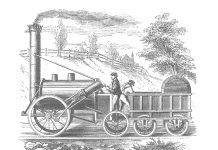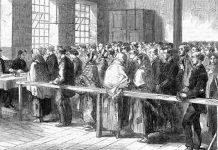As Scotland prepares to vote to leave or stay in the United Kingdom, About Manchester takes a look at the area’s early ties North of the border.
Before the 17th century, there were few Scots in England and probably only a handful in Manchester. That would begin to change after James VI came to London as James I in 1603 bringing with him the first stage of migration.
By the 18th century it had become well enough established for Samuel Johnson to remark about the Nobelist prospect ever sees being the high road to England.
By the end of that century Lancashire and Manchester were becoming magnets for the Scottish immigrant. Scottish names were beginning to appear in the city.Aulay Macauley a tea merchant of St Ann’s Square and Duncan M’Lane a haberdasherer of King Street in the 1770’s.
Twenty five years earlier Scots had arrived in the town as part of Bonnie Prince Charlie’s army heading to confront the Hannoverian regime in London.Many in the town supported them but on their retreat back, there gendered little support.
Now they came for economic reasons.A number of the earliest cotton manufacturers had their origins in Kirkcudbrightshire in the South West, having followed, it was said a machine maker called Cannan.These were the MCdonnells and Kennedy’s of the late 1700’s.
Galloway was at the time, the centre of cotton production in Scotland.It would soon be eclipsed by Glasgow. The South West of Scotland had always strong links with England and as large farms replaced the traditional small holdings, the local trader looked for new markets.Manchester was scarcely less easier to reach than Glasgow at this time and the innovations being made in the cotton industry as it moved from the home to the factory were attractive to these dispossessed people.
Most were young men, either single or just married.They were highly skilled and probably had advanced information about the Labour market. By 1841, outside if London and Liverpool, Manchester had the highest concentration of Scots born people, a figure that would leak at 1.9 per cent of the population in 1871.
Mc Connell and Kennedy and Adam and George Murray were making textile machines.They had all served under Cannan and Smith at Chowbent.
Later would come the engineers, Fairbairn and Galloway, Bowman and Naysmyth who brought Scottish strike breakers from Glasgow with him in 1836.
The Scottish universities, unlike their English counterparts still stuck in the classics, were pioneers of medicine and science and education and training was more practical and aimed at industry.
The Scots have left their mark in the region.The mills still retain their names, science medicine and education bear their imprints.
They left their mark in religion, reintroducing Presbyterianism into the North West. in politics they left their mark.
Archibald Prentice would campaign for the First Reform Act reform and the repeal of the corn laws and a group of Scottish exiles in Manchester would introduce golf to the English although the first club would be opened at Hoylake.
In the next few days we continue looking in more detail at some of the Scots who came South and left their mark on the city







